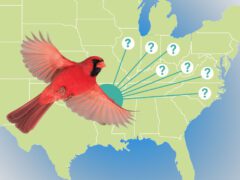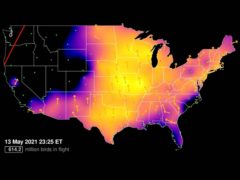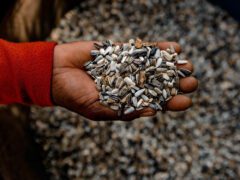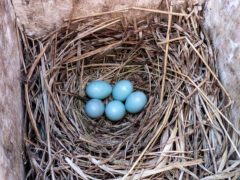The Four Keys to ID
- Size & Shape
A large, bulky goose with a thick neck, large head and bill, and stout legs.
Relative Size
Larger than a Mallard, smaller than a Mute Swan.

 goose-sized or larger
goose-sized or largerMeasurements
- Both Sexes
- Length: 29.9-35.0 in (76-89 cm)
- Weight: 73.0-160.8 oz (2070-4560 g)
- Wingspan: 57.9-70.9 in (147-180 cm)
© Lukasz Pulawski / Macaulay Library
- Color Pattern
Graylag Geese are plain, brownish-gray overall with a mostly white tail and back end. The upperparts are dark brown, the head, neck, and breast are a lighter brownish-gray, and the lower underparts are white. The bill is orange in western European birds and pink in eastern populations, and the legs are pink. In flight, the upperwings have large, striking pale gray patches and the underwings give a distinctive two-toned appearance, with pale gray linings contrasting with darker flight feathers.
© Rui Pereira | Portugal Birding / Macaulay Library - Behavior
Graylag Geese are loud, conspicuous birds often seen in flocks. They graze in grasslands and agricultural fields for favored grasses and crops. They also forage in wetlands, sometimes “tipping up” while sitting on a waterbody to reach submerged vegetation in deeper water.
© Bhaarat Vyas / Macaulay Library - Habitat
Graylag Geese nest in large wetlands, especially with extensive reedbeds, and on small islands in larger lakes. During breeding season, they graze on plants in nearby grasslands, meadows, and wetlands. In winter this species forages on aquatic vegetation in large wetlands or on grasses and crops in nearby grasslands and agricultural fields.
© Aseem Kothiala / Macaulay Library
Regional Differences
Birds breeding in western Europe have an orange bill and are slightly smaller and darker than pink-billed birds that nest from eastern Europe to East Asia. eBird refers to these two groups as Graylag Goose (European) and Graylag Goose (Siberian). Geese in central Europe show intermediate characteristics.
























































